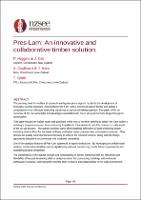| dc.contributor.author | Higgins, Peter | |
| dc.contributor.author | Gin, John | |
| dc.contributor.author | Keen, Jared | |
| dc.contributor.author | Coulthard, Amber | |
| dc.contributor.author | Smith, Tobias | |
| dc.date.accessioned | 2024-07-01T02:01:19Z | |
| dc.date.available | 2024-07-01T02:01:19Z | |
| dc.date.issued | 2024-04-09 | |
| dc.identifier.uri | https://repo.nzsee.org.nz/xmlui/handle/nzsee/2743 | |
| dc.description.abstract | The pressing need for resilient structures in earthquake-prone regions has led to the development of innovative seismic solutions. Among them, PRESSS and Preslam stand out as a groundbreaking approach. This paper offers an overview of the core principles and advantages associated with PRESSS and Preslam systems from design through to construction.
Although gaining in popularity in recent times in New Zealand, there remains many areas of uncertainty. This paper focuses on typical issues and questions which may arise when seeking to adopt PRESSS or Preslam within a building’s footprint/structure. Post-tensioning is applied to these elements, and this process is a critical part of the on-site process. The authors consider some of the practical difficulties of post-tensioning timber, including how to allow for the lower stiffness and higher creep characteristics of timber compared to concrete. They discuss the increased quality control processes necessary to achieve the required tensions, along with the design approaches adopted to accommodate this increased uncertainty.
One of the standout features of PRESSS systems is their rapid construction. By leveraging on prefabricated sections, construction timelines can be significantly reduced by minimizing on-site labour requirements and expediting project completion. Practical approaches for achieving these time savings are shared.
The combination of the natural strength and sustainability of timber combined with the robustness and flexibility of the post-tensioning offers a unique solution for constructing earthquake resistant buildings, addressing the need for both resilience and sustainability in the built environment. | |
| dc.language.iso | en | |
| dc.publisher | New Zealand Society for Earthquake Engineering | |
| dc.relation.ispartofseries | 2024;98 | |
| dc.subject | Other topics related to earthquake engineering | |
| dc.title | Pres-Lam: An innovative and collaborative timber solution | |
| dc.type | Article | |

